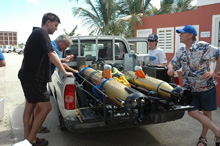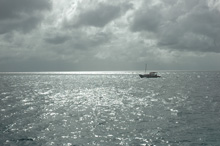Supporting (and Feeding) a Science Expedition
After a great day of testing, both Gavia autonomous underwater vehicles (AUVs) are loaded into the back of a pickup truck to head back to “science headquarters.” Click image for larger view and image credit.
Conducting AUV operations from a boat, Alex Forrest uses a heavy-duty computer to track one of the Gavia AUVs. Click image for larger view and image credit.
January 26, 2008
Susan Patterson
Logistics Coordinator and Public Relations
Virginia Institute of Marine Science, College of William & Mary
Supporting a Science Expedition
The science of a "science expedition" is critical. But what goes on with the people who may not do the science but support the mission? Getting ready for Bonaire means planning to live in a country where there is no Super Walmart, no 24-hour grocery store, and the labels are written in Dutch and in Spanish. It is all in our attitude, and choosing to look at this as a delightful challenge — a way to explore and see what the island's assets are — all add to the experience.
The first stops after arrival were meetings with government representatives, Frank von Slobbe, the secretary of the Commission Marine Environment, and Ramon de Leon, the Stichting Nationale Parken Nederlandse Antillean (STINAPA) park manager. These meetings not only covered the expectations they had for science being done, but what the scientists needed in the way of support. The governmental representatives outlined the areas of the island that they felt most concerned about, as well discussing how the science work could assist them in their protection of the Marine Park and other island resources. It is critical for expeditions to have good working relationships with the local governmental groups. Additionally, as we are using autonomous underwater vehicles (AUVs), the coordination with the local dive businesses is also an important safety factor.
Bonaire is at a point in its growth where managing its resources has long-range implications. Land development (both residential and commercial), cruise ships and their tourists, dive tourists, and associated hotels all impact the health of the Bonaire National Marine Park, and its reefs. Bonaire has worked hard through STINAPA to protect this treasured marine resource.
This is the "Year of the Coral Reef," and working at Bonaire carries with it extra responsibilities so that others — long after us — may enjoy the beauty of Bonaire's wonderful reef system.
An impromptu science meeting on a boat off the island of Bonaire. Click image for larger view and image credit.
Even though we arrived in Bonaire during the rainy season, the sun was always shining. Mid-afternoon clouds and rain would often last for only an hour or two. Click image for larger view and image credit.
Feeding a crew of people is always interesting. Feeding a crew of people on an island where 99% of the food comes in on a weekly cargo ship is an adventure! Then we add in the language for extra challenge.
This expedition includes scientists and other participants from Iceland, England, Canada, and the United States. Needless to say, food tastes, likes, and dislikes vary hugely. After doing the survey of food allergies, food preferences, and the like, we are now ready to prepare menus and shopping lists. Because we are feeding anywhere from 12 to 20 people, dependent on schedules and visitors, we will need to buy in bulk quantities for economical reasons. This is where we are glad that the traditional rental vehicle on the island is a small pickup truck, with a large cab.
Bonaire has a new fresh greens and produce store called La Huerta, which provides excellent service. We also found the Bonaire Food Warehouse and the Cultimara Grocery Store to be the best for our needs. In addition, the island has other small stores more geared to neighborhood quick-needs shopping.
The Bonaire Food Warehouse carries food in both restaurant and residential packaging, which makes it easier for us. The fun begins when you have to convert all the weights and measurements from kilograms to pounds! This is where I become extremely grateful that I paid attention in science and math so the conversion is not too painful. Our menus will feature chicken and fish, with occasional pork chops and delightful melt-in-your-mouth Argentinean beef.
What is terrific about the produce section is the tropical selection of papaya, yucca, plantain, and starfruit. We take full advantage of these great fruit treats. The nice part is that we can work with a vegetarian as easily as we can the omnivores. Fun foods that we have found are hazelnootpasta, pickled fish filets, and coffee that hands-down beats Starbucks! The Douwe Egberts coffee is a terrific find, because one of the things which helps the most with late night data crunching, as well as starting up the crew in the morning, is great coffee.
Cultimara's an in-house bakery turns out some of the best bread any of us have ever eaten. The scent of baking loaves of whole wheat, whole grain, and other specialty bread have us all drooling as we walk into the store. The wheels of cheese, and the varieties of lunch meat boggle the mind. There is no "Oscar Meyer" here.
We learn quickly to watch the harbor for the Don Andreas or the Don Luis, and to wait 24 hours for the goods to be unpacked and put on the shelves. Because we never know from one shipment to the next what will be onboard, we find every shopping trip an adventure.
Sign up for the Ocean Explorer E-mail Update List.






























